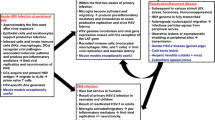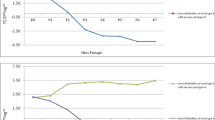Summary
Mice were infected at 4 weeks of age with a type 1 strain of herpes simplex virus (HSV) and re-infected 4 weeks later with either a type 1 or a type 2 strain of HSV. The virus used for first infection could be distinguished from that used later since it was resistant to phosphonoformic acid and formed syncytial plaques. Sites used for the second inoculation were as follows: at the site of primary infection, at a different site within the same dermatome or in the equivalent dermatome on the opposite side (also called “remote” site).
Re-infection caused no detectable reactivation of the latent PFA resistant virus. After re-infection with a homotypic virus replication of the re-infecting virus was limited to the inoculation site. However after heterotypic re-infection the type 2 strain was occasionally isolated from the ganglia. Previous infection with the PFA resistant type 1 strain clearly reduced the ability of the homotypic or heterotypic strains to establish a latent infection. However, in a few animals ganglia were found to be latently infected with virus from both the first and second inoculations. Analysis of the results suggests that resistance to the establishment of a second latent infection in a ganglion is determined by the general immunity of the animal rather than “immunity” of the latently infected ganglion itself.
Similar content being viewed by others
References
Blank H, Haines HG (1973) Experimental human re-infection with herpes simplex virus. J Invest Dermatol 61: 223–225
Blue WT, Winland RD, Stobbs DG, Kirksey DF, Savage RE (1981) Effects of adenosine monophosphate on the reactivation of latent herpes simplex virus type 1 infections in mice. Antimicrob Agents Chemother 20: 547–548
Blyth WA, Harbour DA, Hill TJ (1984) Pathogenesis of zosteriform spread of HSV in the mouse. J Gen Virol 65: 1477–1486
Centifanto-Fitzgerald YM, Varnell ED, Kaufman HE (1982) Initial HSV type 1 infection prevents ganglionic superinfection by other strains. Infect Immun 35: 1125–1132
Gerdes JC, Smith DA (1983) Recurrence phenotypes and establishment of latency following rabbit kerititis produced by multiple herpes simplex virus strains. J Gen Virol 64: 2441–2454
Harbour DA, Hill TJ, Blyth WA (1983) Recurrent herpes simplex in the mouse: inflammation in the skin and activation of virus in the ganglion following peripheral stimulation. J Gen Virol 64: 1491–1498
Hill TJ (1985) Herpes simplex virus latency. In: Roizman B (ed) The herpes-viruses, vol 3. Plenum Press, New York, pp 175–240
Hill TJ, Field HJ, Blyth WA (1975) Acute and recurrent infection with HSV in the mouse: a model for studying latency and recurrent disease. J Gen Virol 28: 341–353
Hill TJ, Blyth WA, Harbour DA (1978) Trauma to skin causes recurrence of herpes simplex virus in the mouse. J Gen Virol 39: 21–28
Klein RJ (1985) Problems with herpes simplex latency. Antiviral Res [Suppl 1]: 111–120
Klein RJ, Friedman-Kein AE, Brady E (1978) Latent herpes simplex virus in ganglia of mice after primary infection and re-inoculation at a distant site. Arch Virol 57: 161–166
Meignier B, Norrild B, Roizman B (1983) Colonisation of murine ganglia by a superinfecting strain of herpes simplex virus. Infect Immun 41: 702–708
Thomas E, Lycke E, Vahlne A (1985) Retrieval of latent herpes simplex virus type 1 genetic information from murine trigeminal ganglia by superinfection with heterotypic virus in vivo. J Gen Virol 66: 1763–1770
Tullo AB, Shimeld C, Blyth WA, Hill TJ, Easty DL (1982) Spread of virus and distribution of latent infection following ocular herpes simplex in the non-immune and immune mouse. J Gen Virol 63: 95–101
Yirrell DL, Blyth WA, Hill TJ, Rogers CE (1989) Experimental in vivo generation of intertypic recombinants of HSV in the mouse. In preparation
Author information
Authors and Affiliations
Rights and permissions
About this article
Cite this article
Yirrell, D.L., Blyth, W.A., Hill, T.J. et al. Heterotypic and homotypic re-inoculation of mice already latently infected with herpes simplex virus type 1. Archives of Virology 110, 25–36 (1990). https://doi.org/10.1007/BF01310700
Received:
Accepted:
Issue Date:
DOI: https://doi.org/10.1007/BF01310700




